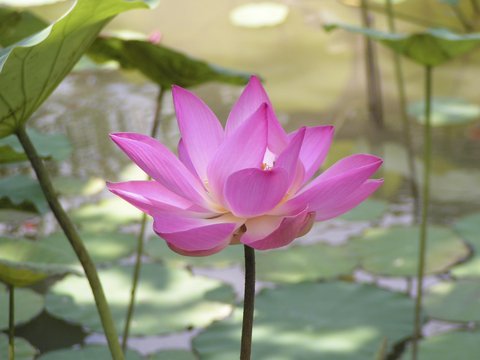Many people begin meditation for its very practical benefits, like stress reduction, and then discover there are even more attractive benefits that come naturally from the practice of being mindful, such as improved judgment, better relationships, a growing sense of well-being and deepening spiritual experiences.

Meditation in a Nutshell
Learning to See Clearly
In this practice we just notice, without any judgment. If our attention stays with our breathing – OK. If our attention wanders – OK. We can also notice and accept where our minds go when they wander. As we practice this simple exercise, we come to see ourselves and the way things really are more clearly, without being clouded or colored by our prejudices, fears or desires. Only when we see and accept things as they are can we begin to change them wisely. This clarity opens our minds and hearts, to let them grow.
Practicing to Live Better
As we meditate more, it begins to work in several ways, often showing up in our lives more than in our meditation. We’ll find it easier to concentrate, because each time we bring our attention back to our breathing, we build our ability to concentrate. It’s just like building up a muscle by doing some exercise over and over.
Concentration enables us to be here now, to focus our minds to deal with problems, or to enjoy good times. It also makes us feel relaxed and peaceful. Most people who begin to meditate notice lots of thoughts buzzing around in their heads. Our brains are like bubble machines, constantly making thoughts that keep floating through our minds, often irritating or urging us to act unwisely. But when we keep our attention on one thing, those thoughts quiet down, and we relax. Gradually we learn to respond to situations, rather than react, in a way that won’t cause harm to us or the people around us.
Have you ever done something when you were stressed out and couldn’t think very well, only to regret it later? When you first start meditating, you may be sorry to notice how often this happens. Some people quit at this point. Others want to change themselves completely, all at once. In fact, this practice will quite naturally lead to change, gradually and gently.
It’s Simple, Just Get Started
It doesn’t require 45 minutes a day to get started – whatever time you have is enough. If you can only meditate for 15 minutes or even just 3, it’s better to do that than put it off until you have a larger block of time.
Find a comfortable position where you won’t need to move for a while, with your back straight enough to breathe freely. Let your eyes close naturally, and turn your attention to your breathing. First, pay attention to your nose or your mouth, that place where the air enters and leaves your body. Notice everything you can about the sensations you feel there, and what they tell you about the way your body breathes.
Don’t take over your breathing, just observe the way your body breathes all the time, in its own wisdom, when you’re not paying attention. From the sensations at your nose or mouth, can you tell if your breathing is deep or shallow? Can you tell if each breath is long, or short? Just gather all the information you can about your breathing from what you feel at your nose or mouth.
Then, shift your attention to your chest, as it rises and falls when you breathe in and out. What sensations do you feel there that are associated with your breathing, and what do they tell you about each breath?
Finally, pay attention to your belly, to the muscle there that pulls the air into your body or relaxes to let it out, and ask yourself the same questions about what you feel there, and what those sensations tell you about your breathing.
Then, from these three places, pick the one where it’s easiest for you to observe yourself breathe, and let your attention rest there, like a swimmer resting on a raft.
When you notice that your attention has wandered, celebrate having noticed. Then invite your attention to return to your breathing. If it is hard to pull your attention away from the thoughts you were thinking, be gentle. There is a balance you can find in the effort to concentrate, which will eventually bring your attention back without making you feel frustrated or bad about yourself. To stay with the practice over time, it’s usually best to begin by taking it easy. Every time you are able to observe a breath in and out, and know you’re observing it, you become more aware, more mindful.
After you have done this practice daily for a while, you may find that you want to meditate longer, or learn more ‘formal’ ways to practice. It’s like physical exercise; you simply feel better when you do it, and start wanting to do more.
The hardest part, really, is getting started, so make it easy, keep it simple, and let yourself deeply enjoy the pleasures it will gradually bring: relaxation, concentration, improved judgment, self-knowledge and acceptance, better relationships with others and, in each person’s own way, spiritual growth.